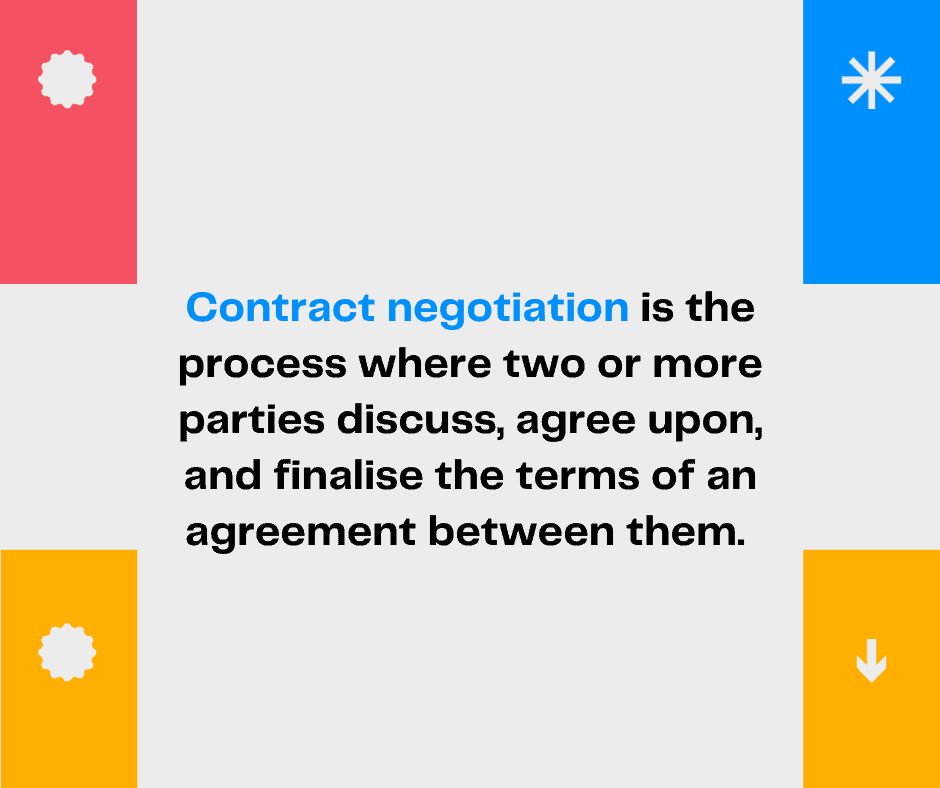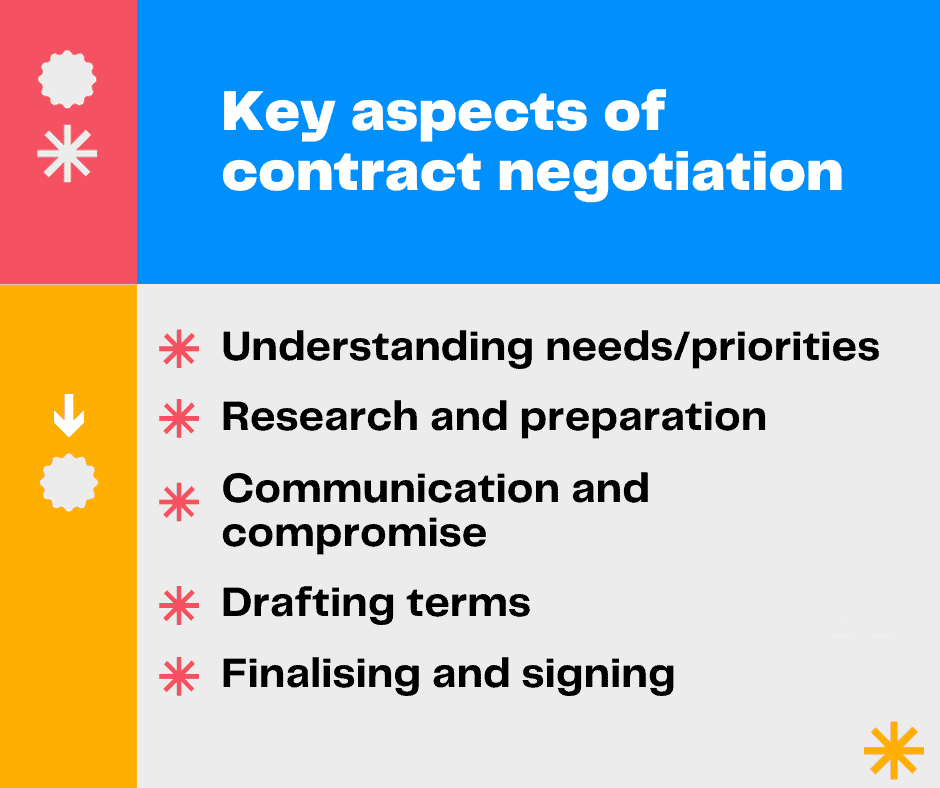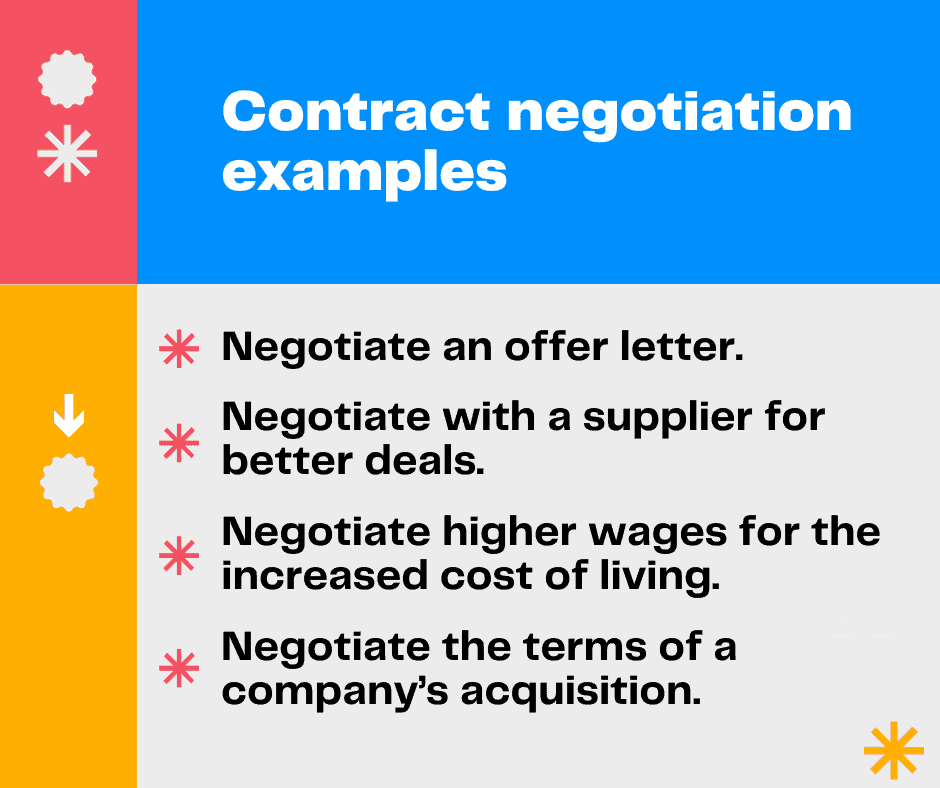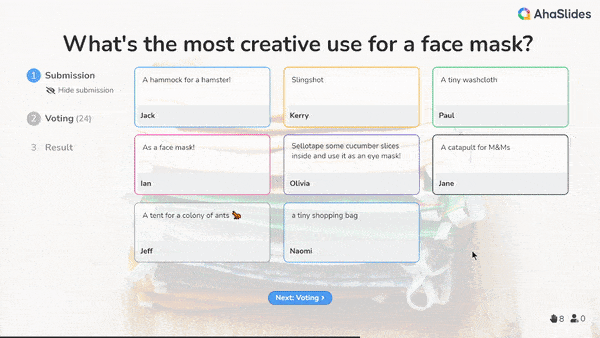什麼是 合同談判? 無論是剛開始做生意還是達成交易的大人物,那些討論條款和談判利益的會議都會讓任何人大汗淋漓。
但其實不必這麼緊張!只要雙方都做好功課,明白真正重要的是什麼,就能找到雙贏的解決方案。
👉 在本文中,我們將詳細分析 合同談判,並分享一些讓雙方都滿意的包裹的實用技巧。
目錄
提高參與度的技巧
什麼是合約談判?

合同談判 是兩方或多方討論、達成協議並最終確定協議條款的過程。
目標是透過談判過程達成雙方都能接受的合約。
合約談判的一些關鍵面向包括:

合約談判範例

您具體什麼時候需要談判合約? 請參閱下面的這些範例👇
• 未來的僱員 正在與一家成長中的新創公司就錄用通知書進行談判。 她希望獲得公司股權作為薪酬的一部分,但該新創公司不願授予大量股權。
• 啟動 正在與一家大型供應商談判,以獲得更好的定價和付款條件來製造他們的新產品。 他們必須利用自己的成長潛力來獲得讓步。• 自由開發者 正在與一位新客戶洽談定製網站建置合約。她希望獲得較高的時薪,但也能理解客戶的預算限制。雙方可能達成妥協,包括延期付款。• 在工會談判期間, 教師 目標是透過增加的生活成本來獲得更高的工資,而學區希望在評估和班級規模方面有更大的靈活性。• 行政人員 在同意從一家被收購的中型公司辭職之前,正在就提高遣散費進行談判。 如果他的新職位在收購後一年內被取消,他希望得到保護。合約談判策略
制定詳細的策略將幫助您在合約中佔上風。讓我們來詳細了解:
💡 另見: 6 個經過時間考驗的成功談判策略
#1. 了解你的底線

研究你的交易對手。 在談判開始之前了解他們的業務、先前的交易、優先事項、決策者和談判風格。
了解誰擁有最終決定權,並根據他們的優先事項調整您的方法,而不是假設一種方法適合所有人。
徹底了解業界標準、對方的立場以及你的 最佳替代方案 (協商協議的最佳替代方案)。
在審視對方立場的同時,集思廣益,提出他們所有可能的需求或要求。知識就是力量。

#2. 起草合約

製作您理想的合約版本作為起點。
始終使用清晰、明確的語言。避免使用定義不明確的術語、模糊的措詞和可能導致誤解的主觀標準。您可以尋求專家的協助來準備一份具體的合約。
明確包含強制性條款和自由裁量性條款。將義務標註為“必須”或“應當”,將選項標註為“可以”,以避免混淆。
積極解決可預見的問題。 添加針對延誤、品質問題和終止等意外情況的保護條款,以避免未來發生糾紛。
仔細起草有助於準確捕捉談判內容,使各方滿意。
#3。 談判

與對方談判時,要積極傾聽。透過提問,充分了解對方的需求、限制和優先事項。
透過您所聽到的內容,透過尊重的對話建立融洽的關係並找到共同點和利益,以使關係朝著積極的方向發展。
明智地妥協。透過創造性的選擇,而不是唯利是圖的「贏」或「輸」的定位,尋找「做大蛋糕」的解決方案。
重複重要的理解和任何商定的更改,以避免以後出現歧義。
在更大的問題上做出小小的讓步,以建立對更重要的人的善意。
使用客觀標準。引用市場規範、過往交易和專家意見,將“想要”轉化為“應該”,並提出替代方案,以激發創造性討論。
透過討論保持冷靜並專注於解決方案,以保持富有成效的氛圍。 特別避免人身攻擊。
#4。 總結清楚

雙方達成協議後,務必口頭重複協議,以避免日後書面合約出現差異。
保留協議的詳細註釋,以減少任何誤解的可能性。
制定決策時間表,使談判保持重點並步入正軌。
透過仔細的規劃和合作策略,大多數合約都可以透過談判實現互惠互利。 雙贏是目標。
合約談判技巧

合約談判不僅涉及技術條款和專業知識,還需要人際溝通能力。 如果您希望合約談判過程輕鬆愉快,請記住以下黃金規則:
- 做好研究-了解產業標準、其他各方以及真正重要/可協商的內容。
- 了解您的 BATNA(談判協議的最佳替代方案)—擁有可以利用的讓步地位。
- 將人與問題分開-保持談判客觀、友好,不進行人身攻擊。
- 清晰地溝通-積極傾聽並明確地、有說服力地傳達立場/利益。
- 在合理的情況下妥協——策略性地做出適度的讓步以獲得回報。
- 尋求「雙贏」-尋找互惠互利的交易,而不是贏者全拿的競爭。
- 口頭確認-清楚重申協議,以避免日後出現誤解。
- 以書面記錄-及時將口頭討論/理解轉化為書面草稿。
- 控制情緒-保持冷靜、專注並控制討論。
- 了解自己的極限-提前設定底線,不要讓情緒超越它。
- 建立關係-培養信任和理解,以便未來的談判更順利。
關鍵要點
合約談判並不總是對你有利,但透過適當和徹底的準備,你可以將充滿壓力的會議和皺著眉頭的臉變成持久的合作關係。
常見問題(FAQ)
合約談判的重點領域有哪些?
合約中通常協商的一些關鍵領域包括價格/付款條款、工作範圍、交付/完成時間表、品質標準、保固、責任和終止。
談判的 3C 是什麼?
談判中經常提到的三個主要「C」是合作、妥協和溝通。
談判的7個基本原則是什麼?
談判的 7 個基本原則:了解你的 BATNA(談判協議的最佳替代方案)——了解利益,而不僅僅是立場——將人與問題分開——關注利益,而不是立場——通過擴大選擇來創造價值——堅持客觀標準——放下驕傲。









